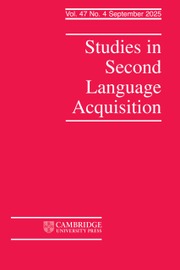Crossref Citations
This article has been cited by the following publications. This list is generated based on data provided by
Crossref.
González-Lloret, Marta
and
Ortega, Lourdes
2014.
Technology-mediated TBLT.
Vol. 6,
Issue. ,
p.
1.
Rost, Michael
2014.
Listening in a Multilingual World: The Challenges of Second Language (L2) Listening.
International Journal of Listening,
Vol. 28,
Issue. 3,
p.
131.
Hashemi Shahraki, Sara
Ketabi, Saeed
and
Barati, Hossein
2014.
Group dynamic assessment of EFL listening comprehension: Conversational implicatures in focus.
International Journal of Research Studies in Language Learning,
Vol. 4,
Issue. 3,
Vandergrift, Larry
and
Baker, Susan
2015.
Learner Variables in Second Language Listening Comprehension: An Exploratory Path Analysis.
Language Learning,
Vol. 65,
Issue. 2,
p.
390.
Brunfaut, Tineke
and
Révész, Andrea
2015.
The Role of Task and Listener Characteristics in Second Language Listening.
TESOL Quarterly,
Vol. 49,
Issue. 1,
p.
141.
Harding, Luke
Alderson, J. Charles
and
Brunfaut, Tineke
2015.
Diagnostic assessment of reading and listening in a second or foreign language: Elaborating on diagnostic principles.
Language Testing,
Vol. 32,
Issue. 3,
p.
317.
Mirzaei, Maryam Sadat
Meshgi, Kourosh
and
Kawahara, Tatsuya
2016.
CALL communities and culture – short papers from EUROCALL 2016.
p.
313.
Ellis, Rod
and
Le, Chang
2016.
The Effects of Inference-Training and Text Repetition on Chinese Learners’ Incidental Vocabulary Acquisition While Listening.
Chinese Journal of Applied Linguistics,
Vol. 39,
Issue. 2,
Toth, Paul D.
and
Davin, Kristin J.
2016.
The Sociocognitive Imperative of L2 Pedagogy.
The Modern Language Journal,
Vol. 100,
Issue. S1,
p.
148.
ADRADA-RAFAEL, SERGIO
2017.
Processing the Spanish imperfect subjunctive: Depth of processing under different instructional conditions.
Applied Psycholinguistics,
Vol. 38,
Issue. 2,
p.
477.
Yamashita, Junko
and
Shiotsu, Toshihiko
2017.
Comprehension and Knowledge Components That Predict L2 Reading: A Latent-Trait Approach.
Applied Linguistics,
Vol. 38,
Issue. 1,
p.
43.
Mirzaei, Maryam Sadat
Meshgi, Kourosh
Akita, Yuya
and
Kawahara, Tatsuya
2017.
Partial and synchronized captioning: A new tool to assist learners in developing second language listening skill.
ReCALL,
Vol. 29,
Issue. 2,
p.
178.
Green, Rita
2017.
Designing Listening Tests.
p.
1.
Matthews, Joshua
O'Toole, John Mitchell
and
Chen, Shen
2017.
The impact of word recognition from speech (WRS) proficiency level on interaction, task success and word learning: design implications for CALL to develop L2 WRS.
Computer Assisted Language Learning,
Vol. 30,
Issue. 1-2,
p.
22.
Rodrigo, Victoria
2017.
Quantifying comprehension gains after repeated listening by students of Spanish with different listening ability: an exploratory study.
Journal of Spanish Language Teaching,
Vol. 4,
Issue. 1,
p.
35.
Green, Rita
2017.
Designing Listening Tests.
p.
27.
Wei, Wei
and
Zheng, Ying
2017.
An investigation of integrative and independent listening test tasks in a computerised academic English test.
Computer Assisted Language Learning,
Vol. 30,
Issue. 8,
p.
864.
Mirzaei, Maryam Sadat
Meshgi, Kourosh
and
Kawahara, Tatsuya
2018.
Exploiting automatic speech recognition errors to enhance partial and synchronized caption for facilitating second language listening.
Computer Speech & Language,
Vol. 49,
Issue. ,
p.
17.
CHO, MINYOUNG
2018.
Task Complexity and Modality: Exploring Learners’ Experience From the Perspective of Flow.
The Modern Language Journal,
Vol. 102,
Issue. 1,
p.
162.
Dirga, R N
and
Wijayati, P H
2018.
How can teachers assess reading skills of generation z learners in German language class?.
IOP Conference Series: Materials Science and Engineering,
Vol. 296,
Issue. ,
p.
012026.




